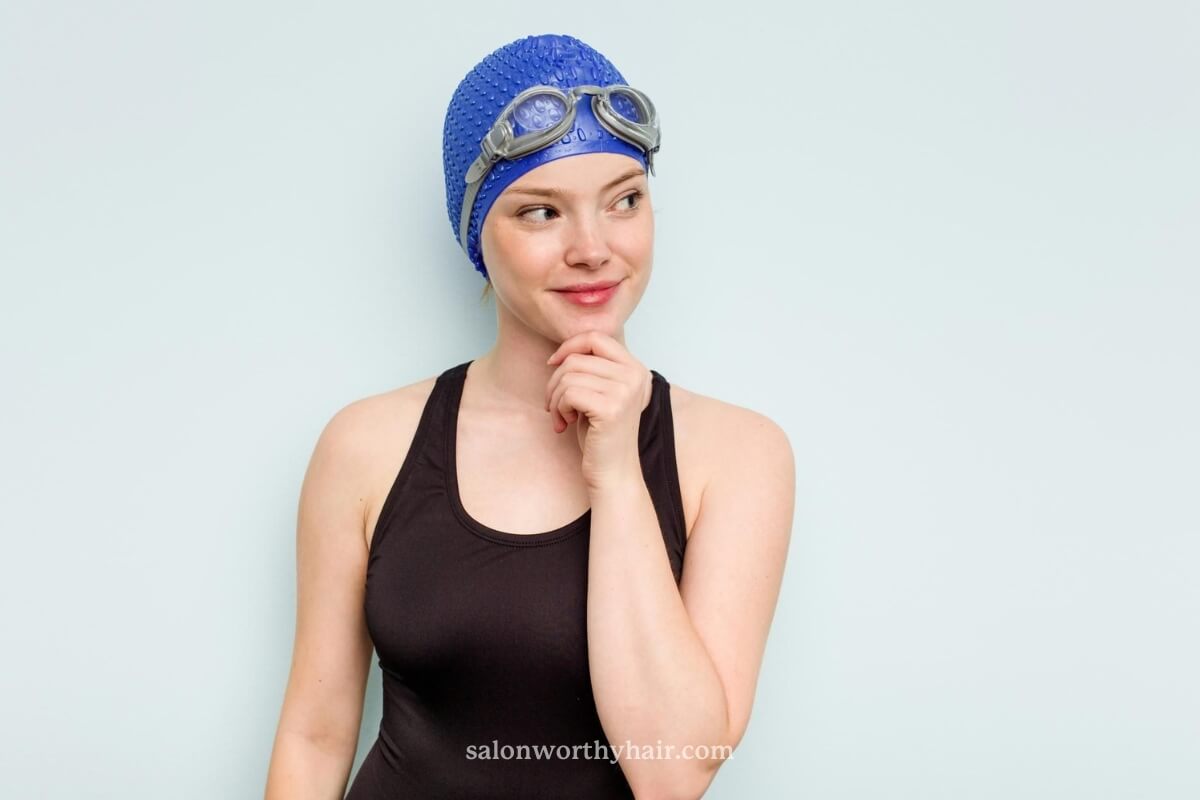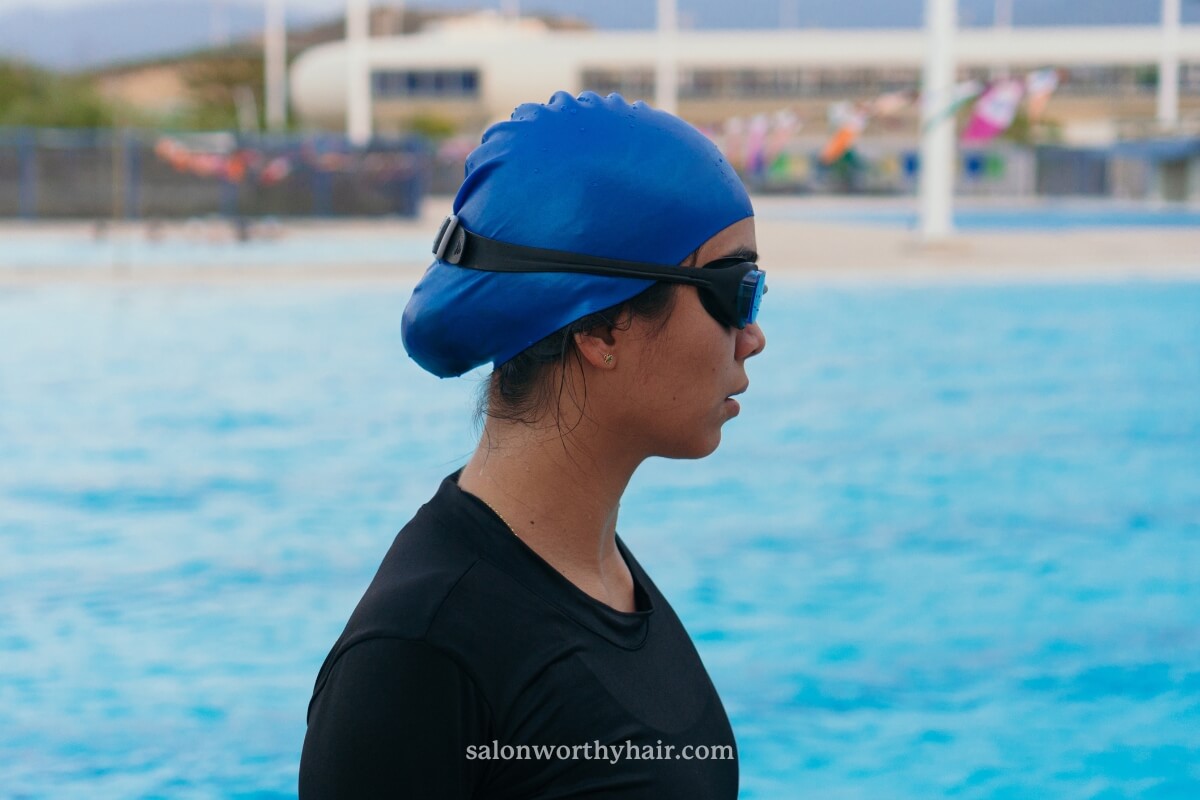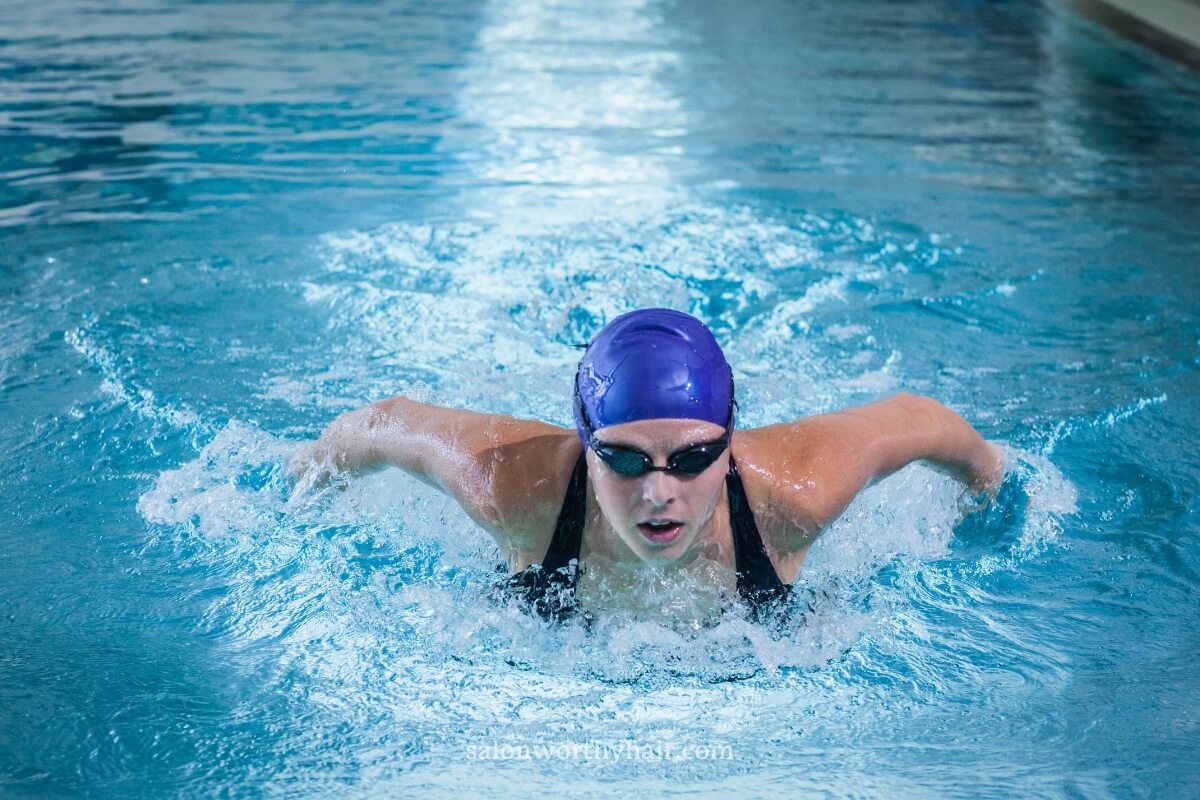Do Swim Caps Keep Hair Dry?
Updated on
This post may contain affiliate links. As an Amazon Associate, we may earn from qualifying purchases.

Many swimmers assume that wearing a swim cap guarantees dry hair throughout their aquatic endeavors. With their tight-fit appearance, swim caps evoke images of professional swimmers gliding effortlessly through the water, their hair untouched.
But are these caps truly capable of keeping the hair 100% dry?
No, Swim Caps Do Not Keep Hair Dry
Swim caps do not keep hair 100% dry due to variables like cap material, individual head shape, hair length, and water pressure while swimming. Their main function is to minimize drag and optimize hydrodynamics during swimming. They also serve to protect hair from chlorine and other pool chemicals. Essentially, swim caps are not designed to keep hair dry.
Swim Caps Are Not 100% Waterproof
Swim caps are not 100% waterproof. They are made from materials like latex or silicone, which are inherently permeable to some extent, allowing water to seep through.
Although swim caps are designed to provide a snug fit over the head, they are not made to create a completely waterproof barrier with your hair. Small gaps or openings can often allow water to enter, particularly during movements like swimming strokes or when the head is submerged. These gaps compromise the cap’s ability to keep the hair completely dry.
Swim caps can also lose elasticity and effectiveness over time, resulting in a looser fit. Stretching and wear can create larger gaps, allowing more water to enter and reducing waterproofing.
Swim Caps Are Less Effective at Protecting Longer Hair
Swim caps are generally less effective at protecting longer hair because longer hair requires more space to accommodate its length and volume. When trying to fit longer hair under a swim cap, it can be challenging to achieve complete coverage. Some sections of the hair may remain exposed or not fit under the cap, leaving them vulnerable to salt water or chlorinated water exposure.

Longer hair can also make it difficult to achieve a tight seal, particularly at the hairline or the nape of the neck. The extra volume and length of the hair can prevent the cap from fully encasing and securing all the hair, allowing water to penetrate.
Longer hair tends to move more and may escape under the aquatic cap during swimming activities. The constant motion of the head and body in the water can dislodge the cap, exposing sections of the hair to water. This movement can also create gaps or openings in the cap, compromising its ability to protect the hair from getting wet.
Even with a secure fit, water can still reach the exposed ends or parts of the hair that extend beyond the swimming cap, resulting in wet hair.
Swim caps have a limited capacity to accommodate long hair. Their design primarily focuses on conforming closely to the head, which can pose challenges for individuals with long and thick hair. The cap may become overstretched or uncomfortable when trying to accommodate more hair, diminishing its ability to keep it dry when swimming.
Individuals with longer hair may need additional measures to protect their hair while swimming. Some options include tying the hair in a bun or braids before wearing the swim cap, using hair clips to secure loose ends, or using protective products such as leave-in conditioners to minimize water absorption.
Movements in Water Create Pressure on the Swim Cap
When a swimmer moves through the water, especially during swimming strokes, diving, flip turns, or other water sports, the movement generates pressure on the swimming cap. The pressure exerted on the swim cap can cause it to compress or shift slightly on the head. This pressure, combined with the force of the water, can result in small gaps or openings forming between the cap and the head.

Others factors that can make hair wet inside a swim cap are:
- Water seepage: As water pressure builds, it can find its way through gaps or openings around the swim cap’s sealing, leading to water seepage. The dynamic movements and pressure changes during swimming can compromise the cap’s ability to maintain a watertight seal.
- Forceful movements: Certain swimming activities involve forceful movements that strain the swim cap more. For example, when diving into the water or performing rapid turns, the impact and sudden change in direction can create strong currents around the cap, increasing the likelihood of water intrusion.
- Cap movement: The pressure and movement in the water can cause the swim cap to shift or slide slightly on the head. This movement can further disrupt the seal and increase the chances of water entering through gaps or openings, especially if the cap is not properly fitted or the swimmer’s head shape does not match the cap’s design.
- Hair Exposure: When water penetrates the swim cap due to pressure and movement, it can come into contact with the hair, leading to partial or complete wetting. Longer hair, in particular, maybe more prone to exposure as it can extend beyond the cap’s coverage.
Swimming Duration Can Affect the Swim Cap’s Effectiveness
Swimming duration can affect a swim cap’s effectiveness in keeping hair dry. The longer the swimmer remains in the water, the greater the impact of pressure and movement on the swim cap. Over time, the cap’s effectiveness in keeping hair dry may diminish as the pressure and water exposure accumulate.
Long swimming durations can affect a swim cap’s permeability. Over time, the cap’s material, such as latex or silicone, may start to allow small amounts of water to permeate through its surface, reducing its overall effectiveness.
Cap degradation:
Continuous exposure to chlorine in pool water or saltwater in the ocean can deteriorate the cap’s material, causing it to become less elastic and more prone to water penetration. As the cap loses its original form and structure, its ability to prevent water from touching your hair diminishes.
Accumulation of Water:
The longer a swimmer stays in the water, the greater the likelihood of water accumulating inside the cap due to water entering through small gaps or openings or sweat and moisture from the scalp. As water accumulates within the cap, it increases the chances of hair coming into contact with moisture, ultimately leading to wetness.
How to Keep Hair Dry When Wearing a Swimming Cap
Tips on how to keep your hair dry when wearing a swimming cap:
- Choose the Right Size: Ensure you select a swim cap that fits comfortably on your head. It reduces the chances of water entering through gaps or openings.
- Consider Using a Silicone Cap: Silicone caps generally provide a tighter seal than latex caps to keep water out more effectively.
- Pull the Cap Down Properly: When putting on the swim cap, pull it down securely, covering your entire hairline and ears for a comfortable fit. Smooth out any wrinkles or folds in the cap to ensure a better seal.
- Tie Up Long Hair: If you have long hair, consider tying it up in a bun or a braid before wearing the swim cap. It minimizes the amount of hair that extends beyond the cap and reduces the risk of water penetration.
- Minimize Cap Movement: Avoid excessive movement of your head while swimming. Sudden head movements or aggressive strokes can pressure the cap, potentially leading to water seepage.
- Use Additional Accessories: To enhance the cap’s effectiveness, you can use additional accessories such as waterproof headbands, swim caps with chin straps, or earplugs. These accessories provide extra layers of protection against water entry. You can also slip a shower cap under your swimming cap for extra protection.
- Avoid Touching or Adjusting the Cap: Once you have put on the swim cap, avoid touching or readjusting it frequently. Doing so can disrupt the seal and increase the chances of water entering.
Best Waterproof Swimming Caps to Keep Hair Dry
While no swim cap can guarantee 100% dryness, some caps are designed to provide better water resistance and minimize water entry. Here are some types of swim caps known for their water-repellent properties:
- Premium Silicone Swim Caps: Silicone caps are often considered more effective in keeping hair dry than latex caps. They have a smoother surface and offer a tighter seal, reducing the likelihood of water seepage.
- Neoprene Swim Caps: Neoprene caps are thicker and provide additional insulation, making them suitable for colder water. Their increased thickness can offer better resistance to water penetration, potentially keeping hair drier.
- Dome Caps or Bubble Caps: Dome caps, also known as bubble caps, have a rounded shape that creates extra space for accommodating long hair. These caps can provide better coverage and reduce the chances of hair exposure to water.
- Lycra Swim Caps: Lycra caps are made from a stretchy fabric that can provide a snug fit. While they may not be as effective at keeping hair completely dry, they can offer protection against water.
Beemo Swim Cap With Chin Strap
Check out: The best swim caps we recommend.About the Author
 Tina Moretti
Tina MorettiTina Moretti, a passionate hair care enthusiast with over a decade of expertise, dedicates herself to empowering women with proven hair care advice. Recognized for her hands-on experience and trusted guidance, Tina turns every strand into a statement of beauty and confidence.
